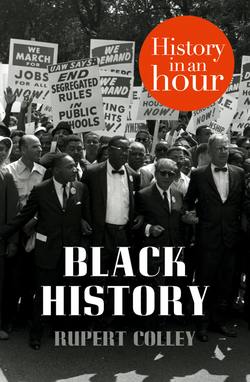Читать книгу Black History: History in an Hour - Rupert Colley - Страница 8
ОглавлениеNorth and South:
‘If slavery is not wrong, nothing is wrong’
Only one in four Southern families owned a slave, but the whole economy and society was based on slavery and the fear of insurrection was constant. There are on record over 250 known incidences of revolt. Denmark Vesey, a freed slave, spent years planning a huge insurrection and had attracted almost 5,000 African-Americans to his cause. But in 1822, Vesey was found out, captured and executed, along with his ringleaders.
In 1831 in Virginia, Nat Turner, a slave who had learnt to read and write and who had turned to Christianity, believed that God had ordered him to slay his enemies. A solar eclipse in mid-August 1831 convinced Turner of the necessity and timing and on 21 August he killed his master and his master’s family. Leading a gang of trusted slaves, Turner led an orgy of killing that lasted twenty-four hours before troops took control. In retaliation, local whites killed over 100 slaves at random. Turner, having eluded capture until 30 October, was tried, convicted and executed. Laws were subsequently passed to restrict the education of slaves.
Harriet Tubman (far left) with rescued slaves, c.1885
Many escaped slaves fled to the North and sometimes on to Canada via an escape route known as the Underground Railroad. The railroad consisted of a series of safe houses, transport facilities and guides to help the runaways escape. Between 1830 and 1860 the railroad helped over 3,000 slaves to freedom and safety. Its most famous organizer, Harriet Tubman (pictured above with some rescued slaves), went on to become a Union spy during the civil war.
The population of the US was growing at an incredible rate: from 7.2 million in 1810 to almost 10 million a decade later. By 1860 this had increased threefold to over 30 million, and New York had become the third largest city in the world (behind London and Paris). The increasing birth rate contributed, but it was mainly immigration, particularly from Ireland and Germany, people attracted by the vast tracts of land available in the west, that caused the dramatic rise. Conflicts arose with the Native Indians, but the expansion westwards was inevitable.
As the white population expanded, newly settled areas, or territories, asked to be admitted into the Union. To maintain the balance between slave states and free states, territories were admitted two at a time. By 1819, the United States was comprised of twenty-two states, eleven free states from the North, and eleven slave states from the South.
This informal arrangement became policy following the Missouri Compromise of 1820. In 1820, Missouri petitioned to be admitted into the Union as a slave state, despite its proximity to free states. Senator Henry Clay suggested allowing Missouri in as a slave state but to maintain the 50/50 ratio, to admit Maine as a free state. More significantly, the Compromise stated that, with the exception of Missouri, no new state containing slavery would be allowed above the line of 36 degrees 30 minutes.
Whilst the Southern states tried to paint a paternalistic and benevolent picture of the relationship between master and slave, the anti-slavery movement of the North, inspired by Britain’s lead in 1834, continued to press for total abolition. In 1847 Frederick Douglass, a slave who had escaped and won his freedom, began the weekly abolitionist newspaper, the North Star. In May 1851, Sojourner Truth, a freed slave, delivered her influential ‘Ain’t I a Woman?’ speech at a women’s rights convention in Akron, Ohio, in which she compared herself to white women, who were accorded respect, and asked why the same was not the case for black women. In 1852, Harriet Beecher Stowe published the influential Uncle Tom’s Cabin which portrayed, in dramatic fashion, the life of the slave in the American South.
But in 1857, the abolitionist cause was dealt a severe blow following the verdict of the Dred Scott case. Scott, a slave from Missouri, tried to sue his owner on the grounds that he had lived with him in Illinois, a state where slavery had been outlawed. The US Supreme Court ruled that blacks were not eligible as US citizens therefore had no recourse to the US legal system. Furthermore, a slave did not become free merely by entering a free state. A Negro, in short, had no more legal rights than an ass.
In 1860, Abraham Lincoln (pictured below) was elected the sixteenth US president, representing the newly formed Republican Party, a party established by the anti-slavery lobby. Lincoln took up his post saying, ‘I believe this government cannot endure permanently half slave and half free.’ Lincoln described himself as ‘naturally anti-slavery.’ ‘If slavery is not wrong,’ he wrote in a letter in April 1864, ‘nothing is wrong.’
Abraham Lincoln, 1865 Photograph by Henry F. Warren
Lincoln’s electoral success convinced the South that the days of slavery were numbered. On 20 December 1860, South Carolina formally withdrew, or seceded, from the Union of the United States. Within seven weeks, six more states had seceded and together they formed the Confederate States of America, also known as the Confederacy, with Jefferson Davis as its president. Once the civil war had started, on 12 April 1861, another four states followed suit.
